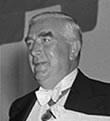CONDOLENCE MOTION THE LATE SIR EARLE PAGE"
Speech by the Prime Minister, the Rt. Hon. R. G. Menzies,
in the House of Representatives,
Tuesday, 20th February, 1962
As Honourable Members know, Sir Earle Christmas Grafton Page died on December 20, 1961.
He was born in 1880. He became a notable surgeon. He served in the first A. I. F. as a surgeon, in Egypt and France.
Urged on by an enthusiasm ; rhich marked the whole of his public life for national development, an"* particularly rural
growth, he entered this Parliament in 1919 as the member for Cowper, a seat which he held continuously until the recent electicn.
He became leader of the Country Party in 1921, an office
which he held until 1939. On February 9, 1923, he became
associated, as Treasurer, with Mr. Bruce ( as he then was) in the
Bruce-Page Government, uhich held office until October 1929.
During this period, in 1924-25, he led an Australian
delegation to the United Kingdom and the United States of
America, to examine banking, electricity, and road and rail
transport. In 1923 and again in 1926 he was Acting Prime Minister.
In 1934 he entered the Lyons Government as Minister for
Commerce, an f fice which he retained until April 1939 doing much
significant work in the field of orderly marketing, and was
Minister for Health from November 1937 to November 1938. He was
the leader of Australian Ministerial trade delegations to London
in 1936 and 1938.
He acted as Prime Minister in 1935 and 1937.
On the death of the Rt. Honourable J. A. Lyons, Sir
Earle Page became Prime Minister from April 7 to April 26, 1939.
From October 1940 to October 1941 he was Minister for
Commerce first in my own Government and then in the Fadden
Government. He aas a member of the Australian 4ar Cabinet from
January to May 1941, and of the Economic and Industrial Committee
of Cabinet from June to October of that year. In 1941-42 he
represented Australia in the British War Cabinet.
He was a member of the Australian Advisory Jar Council
from August 1942 to September 1943 and again from February 1944
to August 1945. In December 1949 he became Minister for Health in my own
Government, and retained that portfolio until 1956, when he
expressed a wish to retire from Ministerial office.
From July to September 1951 he visited Canada a-d the
United States of America to study problems of health
administration. In August-September 1953 he visited the United Kingdom
and the Netherlands, and attended a conference of the World
Medical Association at the Hague.
He represented the Government at the inauguration of
the Republic of Pakistan in March 1956.
2.
Over a long puriod, from 1923 to 1934, and again from
1937 onwards, ho was a rmember of the Standing Orders Committee.
His public career, oven as stated in this summary form,
was a very remarkable one. Few ren have served Australia with
such distinction in so many ways over so long a period of time.
But the record does not end there. It is a difficult
task to select the outstanding features of the versatile % vork he
did. But perhaps I might venture to refer briefly to three of a
number of matters which should be on the record.
The first is that, conscious of the need for
strengthening the rural economy, he was ? argely responsible for
many special taxation and other provisions designed to encourage
capital improvement on the land, and with it the essential
improvement of efficiency and production.
The second is that, as Commonwealth Treasurer, he was a
loader in the creation of the Financial Agreement and the Loan
Council, each of which has had a permanent and far-reaching
effect upon the financial relations of the Commonwealth and the
States. The third is that he was the prime author of and
driving force behind the Commonwealth Medical and Health schemes
which are now successfully operating in Australia.
His labours wore recognised when he was made a Privy
Councillor in 1929, a G. C. M. G. in 1938, and a Companion of Honour
in 1942. But even more importantly he will be honoured and
remembered with gratitude for his great contributions to the
development of the Australian Nation, its institutions and its
policies. All Honourable Members, both new and old, and of
whatever party, will join with me in expressing appreciation of
his public service, and in expressing to the family our sense of
recognition and of loss.
Mr. Speaker, I move that this House expresses its deep
regret at the death on 20th December, 1961, of the Right Honourable
Sir Earle Christmas Grafton Pago, a Member of this
House from 1919 to 1961 and a former Prime Minister of the
Commonwealth, places on record its appreciation of his long and
meritorious public service and tenders its profound sympathy to

